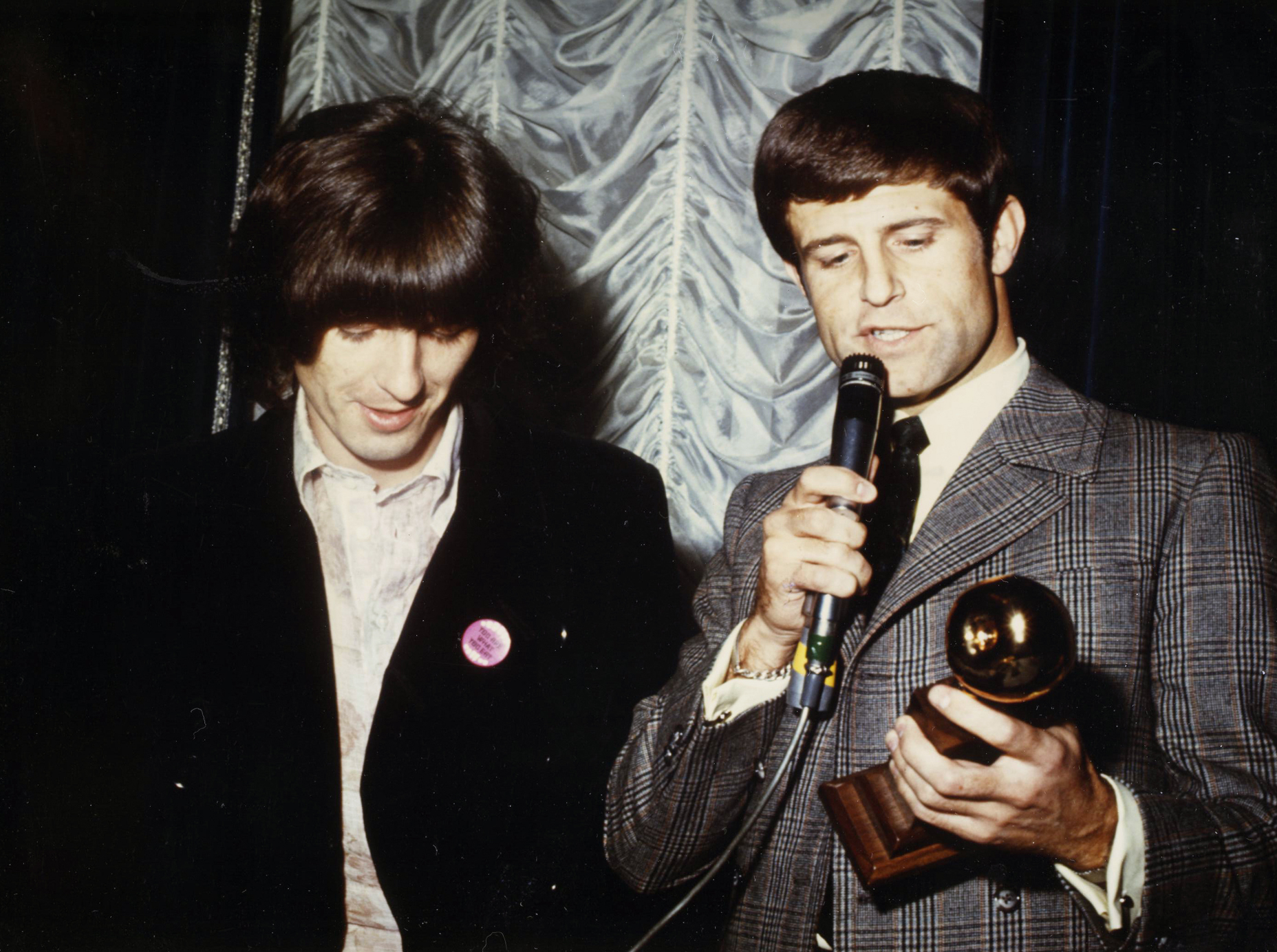When it comes to epic the Guitar Solos by George Harrison, affectionately known as the “quiet Beatle,” was an extraordinary guitarist whose work continues to inspire musicians around the world. His unique style and melodic genius have left a lasting impact, both as a member of The Beatles and later with the Traveling Wilburys. Harrison’s guitar solos are celebrated for their melodic beauty, technical brilliance, and emotional depth. In this article, we delve into some of George Harrison’s greatest guitar moments, highlighting the unforgettable solos that define his enduring legacy.
Cover Photo Credit “Don Grierson with George Harrison Golden Apple Award” by Don Grierson is licensed under CC BY-SA 4.0
The Beatles Era: From Novice to Master
George Harrison’s journey as a guitarist began with The Beatles, where his style evolved significantly over the years. His growth as a musician during this time is a testament to his dedication and innovative spirit. Let’s take a closer look at some of his standout solos from this iconic period, illustrating his transformation from a novice to a master guitarist.
“While My Guitar Gently Weeps”
“While My Guitar Gently Weeps,” featured on the 1968 “White Album,” is one of George Harrison’s most memorable contributions to The Beatles’ discography. The solo in this track is a masterpiece of emotional expression, showcasing Harrison’s ability to convey deep emotion through his guitar playing. The solo is both powerful and poignant, with each note carefully crafted to complement the song’s melancholic lyrics.
Eric Clapton, a close friend of Harrison, played lead guitar on the track, but it was Harrison’s vision that shaped the solo. Harrison insisted on having Clapton play, bringing a unique collaboration that remains a highlight in rock history. This decision not only demonstrates Harrison’s humility but also his ability to recognize and utilize the strengths of his peers to enhance his own music. The resulting solo is a blend of Clapton’s technical prowess and Harrison’s emotional depth, creating a timeless piece of music.
The collaboration between Harrison and Clapton on this track set a precedent for future musical partnerships. It showcased Harrison’s openness to collaboration and his willingness to share the spotlight for the sake of artistic integrity. This approach would later influence his work with the Traveling Wilburys, where he seamlessly blended his style with those of other legendary musicians.
“Something”
“Something,” from the “Abbey Road” album, is another example of Harrison’s genius as a guitarist. The solo in this song is often hailed as one of his best, characterized by its smooth, lyrical quality. The guitar work perfectly captures the romantic essence of the song, making it a timeless classic that continues to resonate with listeners across generations.
Harrison’s use of slides and bends adds a soulful touch, demonstrating his technical prowess and deep understanding of musical expression. Each note in the solo seems to tell its own story, weaving together to create a narrative that is both personal and universal. This ability to evoke emotion through melody is a hallmark of Harrison’s style and a key reason why his solos continue to be celebrated.
The creation of “Something” also highlights Harrison’s growth as a songwriter during his time with The Beatles. His confidence in his own abilities had grown, allowing him to craft a song that stands alongside Lennon and McCartney’s compositions. The solo in “Something” is a testament to Harrison’s ability to create a melody that resonates with listeners on a personal level, a skill that would define his post-Beatles career.
“Here Comes the Sun”
Another gem from the “Abbey Road” album, “Here Comes the Sun” features a delightful guitar solo that reflects the song’s uplifting theme. Written during a time of personal renewal for Harrison, the bright, optimistic solo mirrors his positive outlook and newfound sense of hope. This track remains one of Harrison’s most beloved contributions to The Beatles’ catalog.
The intricate fingerpicking pattern in the song’s intro is iconic, showcasing Harrison’s skill as an acoustic guitarist. This technique adds a layer of complexity to the song, demonstrating his versatility and mastery of the instrument. The solo itself is a masterclass in melody and timing, with each phrase building upon the last to create a sense of joy and warmth that is infectious.
“Here Comes the Sun” also illustrates Harrison’s ability to capture the essence of a moment through music. The song was written during a difficult period, yet it radiates positivity and renewal. This duality is a testament to Harrison’s skill as a musician and his ability to use music as a tool for emotional expression and healing.
Solo Career and Beyond: A New Chapter
After The Beatles disbanded, George Harrison embarked on a successful solo career, further cementing his status as a legendary guitarist. His work during this period continued to captivate audiences with its innovation and emotional depth. Harrison’s solo career allowed him the freedom to explore new musical avenues and develop his own voice as an artist.
“My Sweet Lord”
“My Sweet Lord,” Harrison’s first solo single, features a simple yet effective guitar solo that complements the song’s spiritual message. The use of slide guitar in this track became a signature element of Harrison’s style, adding a distinctive sound that set his music apart. This song not only marked Harrison’s emergence as a solo artist but also his ability to convey profound emotion through his music.
The solo in “My Sweet Lord” is a beautiful example of how Harrison could convey profound emotion with minimalistic playing. His ability to let each note breathe and resonate with listeners is a hallmark of his artistry. This approach to guitar playing emphasizes the power of melody and emotion over technical complexity, a philosophy that would guide Harrison throughout his solo career.
The success of “My Sweet Lord” also demonstrated Harrison’s ability to connect with a broad audience on a spiritual level. The song’s universal themes of love and devotion resonated with listeners worldwide, solidifying Harrison’s reputation as a solo artist capable of creating music that transcends cultural and religious boundaries.
“Give Me Love (Give Me Peace on Earth)”
In “Give Me Love (Give Me Peace on Earth),” Harrison’s slide guitar work shines once again. This track, from the “Living in the Material World” album, features a solo that is both intricate and heartfelt. The combination of melodic lines and gentle slides creates a sense of peace and tranquility, perfectly aligning with the song’s theme of seeking solace and harmony in a chaotic world.
Harrison’s ability to blend technical skill with emotional depth is evident in this solo, making it one of his most revered performances. Each note is infused with a sense of yearning and hope, reflecting Harrison’s personal quest for inner peace. This ability to convey complex emotions through his music was a defining feature of Harrison’s solo career.
“Give Me Love (Give Me Peace on Earth)” also highlights Harrison’s commitment to using his music as a force for positive change. The song’s message of peace and love resonated with listeners during a tumultuous time, and its enduring appeal continues to inspire new generations of musicians and fans alike.
“All Things Must Pass”
The title track from Harrison’s acclaimed solo album, “All Things Must Pass,” features a solo that is both reflective and uplifting. The guitar work in this song is a testament to Harrison’s ability to convey a sense of acceptance and hope, even in the face of life’s uncertainties. This track exemplifies Harrison’s skill in using music as a means of personal expression and reflection.
The solo in “All Things Must Pass” is characterized by its gentle, flowing melody and nuanced phrasing. Harrison’s use of dynamics and timing adds depth to the solo, creating a sense of movement and progression that mirrors the song’s themes of change and renewal. This ability to capture the essence of a moment through music is a hallmark of Harrison’s style and a key reason why his solos continue to resonate with listeners.
The success of “All Things Must Pass” also demonstrated Harrison’s ability to craft a cohesive and compelling solo album. This achievement marked a significant milestone in his career, solidifying his reputation as a solo artist capable of creating music that stands on its own merits.
The Traveling Wilburys: A New Collaboration
In the late 1980s, George Harrison joined forces with Bob Dylan, Tom Petty, Jeff Lynne, and Roy Orbison to form the Traveling Wilburys. This supergroup allowed Harrison to explore new musical avenues, resulting in some unforgettable guitar work. The collaboration with these legendary musicians provided Harrison with a fresh creative outlet and an opportunity to blend his style with those of his esteemed peers.
“Handle With Care”
“Handle With Care” is one of the Traveling Wilburys’ most popular tracks, featuring a catchy guitar riff by Harrison. The solo in this song is a testament to his ability to craft memorable melodies that enhance the overall composition. Harrison’s contribution to the Traveling Wilburys showcased his versatility as a guitarist, blending seamlessly with the styles of his fellow band members.
The guitar work in “Handle With Care” is characterized by its playful and upbeat nature, reflecting the camaraderie and joy of the collaboration. Harrison’s ability to create a solo that complements the song’s lighthearted theme is a testament to his adaptability and skill as a musician. This track remains a fan favorite, highlighting the enduring appeal of Harrison’s guitar work.
The success of “Handle With Care” also demonstrated Harrison’s ability to collaborate with other musicians while maintaining his unique voice as a guitarist. This ability to balance collaboration and individuality is a hallmark of Harrison’s career, allowing him to create music that is both distinctive and universally appealing.
“End of the Line”
Another standout track from the Traveling Wilburys, “End of the Line,” features a laid-back guitar solo by Harrison. The solo complements the song’s relaxed vibe, adding a touch of sophistication and elegance to the arrangement. Harrison’s work with the Traveling Wilburys demonstrated his ability to collaborate with other musicians while maintaining his unique voice as a guitarist.
The guitar work in “End of the Line” is characterized by its smooth, flowing melody and gentle phrasing. Harrison’s use of dynamics and timing adds depth to the solo, creating a sense of movement and progression that enhances the overall composition. This ability to craft a solo that complements the song’s theme is a testament to Harrison’s skill as a guitarist and his intuitive understanding of musical expression.
The success of “End of the Line” also highlighted Harrison’s ability to create music that resonates with listeners across generations. This track remains a fan favorite, illustrating the timeless appeal of Harrison’s guitar work and his enduring legacy as a musician.
“Not Alone Any More”
“Not Alone Any More” is another highlight from the Traveling Wilburys, featuring a poignant guitar solo by Harrison. The solo in this track is characterized by its emotional depth and lyrical quality, reflecting the song’s themes of companionship and hope. Harrison’s ability to convey a wide range of emotions through his guitar work is a testament to his skill as a musician and his intuitive understanding of musical expression.
The guitar work in “Not Alone Any More” is a masterclass in melody and phrasing, with each note carefully crafted to complement the song’s lyrics. Harrison’s use of dynamics and timing adds depth to the solo, creating a sense of movement and progression that enhances the overall composition. This ability to craft a solo that resonates with listeners on an emotional level is a hallmark of Harrison’s style and a key reason why his music continues to inspire new generations of musicians.
The success of “Not Alone Any More” also demonstrated Harrison’s ability to collaborate with other musicians while maintaining his unique voice as a guitarist. This ability to balance collaboration and individuality is a hallmark of Harrison’s career, allowing him to create music that is both distinctive and universally appealing.
Legacy and Influence
George Harrison’s guitar work has left an indelible mark on the world of music. His solos are celebrated not only for their technical brilliance but also for their emotional impact. Harrison’s ability to convey a wide range of emotions through his playing has inspired countless musicians and continues to resonate with audiences today. His legacy as a guitarist is evident in the countless artists who cite him as an influence, from Eric Clapton to Tom Petty.
Influencing a New Generation of Musicians
Harrison’s ability to blend melody, emotion, and technical skill has set a standard for guitarists across genres. His influence can be heard in the work of countless musicians, from rock and pop to folk and blues. Many contemporary artists cite Harrison as a key inspiration, drawn to his ability to create music that is both accessible and deeply moving. This enduring influence is a testament to Harrison’s impact on the world of music and his lasting legacy as a guitarist.
The Emotional Power of Harrison’s Solos
One of the defining features of Harrison’s guitar work is its emotional depth. His ability to convey a wide range of emotions through his playing has made his solos some of the most memorable in music history. Whether capturing joy, sorrow, love, or longing, Harrison’s guitar work resonates with listeners on a personal level. This emotional power is a hallmark of Harrison’s style and a key reason why his music continues to inspire and move audiences today.
A Legacy of Innovation and Creativity
Harrison’s legacy as a guitarist is also marked by his innovation and creativity. Throughout his career, he pushed the boundaries of what was possible with the guitar, experimenting with new techniques and sounds. His willingness to take risks and explore new musical avenues has left a lasting impact on the world of music, inspiring countless musicians to follow in his footsteps. This legacy of innovation and creativity continues to resonate with audiences, ensuring that Harrison’s influence will be felt for generations to come.
Conclusion
George Harrison’s unforgettable guitar solos have cemented his status as one of the greatest guitarists of all time. From his early days with The Beatles to his solo career and work with the Traveling Wilburys, Harrison’s contributions to music are unparalleled. His ability to create memorable melodies and convey deep emotion through his playing continues to inspire new generations of musicians.
As we reflect on George Harrison’s greatest guitar moments, we are reminded of the power of music to connect us and evoke emotion. His legacy lives on through his timeless solos, ensuring that his influence will be felt for years to come. Harrison’s music serves as a testament to the enduring power of melody and emotion, inspiring musicians and listeners alike to explore the depths of their own creativity and expression.











